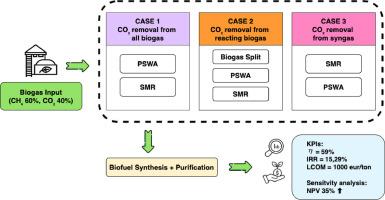Comparative techno-economic analysis on a biogas reforming plant: Case study on partial upgrading with a pressure swing water absorption
IF 4.3
2区 工程技术
Q2 ENGINEERING, CHEMICAL
引用次数: 0
Abstract
The state-of-the-art biogas valorisation process is the combustion. However, the low margin for this operation fosters interest in alternative biogas valorization options. Biogas conversion into bio-syngas and the consecutive synthesis of biofuels is a promising possibility. A biogas-to-biomethanol process is analysed, using a pressure-swing water absorption unit. Three case studies are evaluated for a 1MWe biogas plant, testing the CO2 removal layout for methanol production. The better performance, methanol yield of 112% and internal rate of return of 15.29%, requires a CO removal upstream from the reformer unit, and only for the reacting stream. Results indicate a levelized cost of methanol of 1000 €/ton. Furthermore, the synthesis operating pressure impacts the key performance parameters, allowing for a 35% net present value increase. This paper shows that biogas reforming combined with PSWA is an ideal option to produce cheap raw material for chemical synthesis, ideal for many fuel synthesis processes.


某沼气重整装置的技术经济比较分析——以变压吸水装置部分改造为例
最先进的沼气增值过程是燃烧。然而,这种操作的低利润促进了对替代沼气增值选择的兴趣。沼气转化为生物合成气并连续合成生物燃料是一种很有前景的可能性。采用变压式吸水装置对沼气制生物甲醇工艺进行了分析。对一个1MWe沼气厂的三个案例进行了评估,测试了甲醇生产的二氧化碳去除布局。较好的性能,甲醇收率为112%,内部回收率为15.29%,需要从重整装置上游去除CO2,并且仅用于反应流。结果表明,甲醇的平准化成本为1000欧元/吨。此外,综合作业压力会影响关键性能参数,从而使净现值增加35%。研究表明,沼气重整与PSWA相结合是生产廉价化学合成原料的理想选择,是许多燃料合成工艺的理想选择。
本文章由计算机程序翻译,如有差异,请以英文原文为准。
求助全文
约1分钟内获得全文
求助全文
来源期刊

Chemical Engineering Science
工程技术-工程:化工
CiteScore
7.50
自引率
8.50%
发文量
1025
审稿时长
50 days
期刊介绍:
Chemical engineering enables the transformation of natural resources and energy into useful products for society. It draws on and applies natural sciences, mathematics and economics, and has developed fundamental engineering science that underpins the discipline.
Chemical Engineering Science (CES) has been publishing papers on the fundamentals of chemical engineering since 1951. CES is the platform where the most significant advances in the discipline have ever since been published. Chemical Engineering Science has accompanied and sustained chemical engineering through its development into the vibrant and broad scientific discipline it is today.
 求助内容:
求助内容: 应助结果提醒方式:
应助结果提醒方式:


